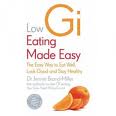I am sure you heard about Glycemic Index foods!
And more specifically people suffering from diabetes, and even more specifically, people suffering from type- 2 diabetes (that occurs at later stages because insulin released from pancreas is not working, not because they don’t have insulin like type- 1 diabetes).
By definition:
The glycemic index (GI), compares equal quantities of carbohydrates in foods. It measures their effect on blood glucose after 2 hours of eating.
It is actually a percentage that provides a measure of carbohydrates quality.
Low glycemic index: 55 and under
Medium glycemic index: 56 to 69
High glycemic index: 70 and above.
Usually people with type- 2 diabetes should consume a low to medium glycemic index foods, depending on each case because these are the foods that won’t raise blood glucose levels too high.
Some people think that when having diabetes, they should cut off all carbohydrates, but this is so wrong!
Eating specific amounts of carbohydrates that have low glycemic index is the key!
Let’s start:
1- Traditional starchy foods have the lower GI:
Barely: 33
Legumes and beans: 30
Pastas: 40
Muesli: 50
Oats: 50
2- Sugary foods have a low to intermediate GI:
Soft drinks: 60
Flavored milk: 34
Sweetened juices: 56
Sweetened yogurt: 33
Low- fat ice cream: 48
3- Modern starchy foods have a high GI:
Potatoes: 85
Cornflakes: 77
White bread: 70
Crisp bread: 81
Most types of rice: 83
Other short term side effects when consuming high GI foods include:
– constipation, dehydration and bad breath
Other long-term effects when consuming high GI foods include:
– Osteoporosis, kidney diseases and some cancers.
Putting it into practice??
Let’s talk about the 5 food groups of the food guide pyramid:
1- Bread, grains and cereal:
Lower GI food choices:
– Bread: Go for whole grain bread or pita bread
– Cereals: Go for porridge, all bran, muesli or special K
– Rice: Go for basmati rice
– Pastas: Go for all varieties and for noodles
2- Vegetables and legumes:
Lower GI food choices:
– starchy vegetables: Go for sweet corn
– legumes: Go for lentils, chick peas and kidneys beans
3- Fruits
Lower GI choices:
– Apples, oranges, pears, canned peaches, dried apricots, cherries, kiwis, grapefruit and plums.
Stay away from juices as they are considered high GI, have no fiber, and have plenty of sugar.
4- Dairy products:
Lower GI choices:
All variety of low-fat milk, yogurt, ice cream and custard
5- Meat, poultry, eggs and nuts:
Lower GI choices:
These items don’t contain carbohydrates and are listed as proteins.
But if you suffer from diabetes, you have to take care of the amount of fat these foods contain.
So go lean and choose cooked fish fillet, cooked legumes, lean meat and skinless chicken.
How can you tell from the food label whether a carbohydrate containing food is a good choice?
Of course, it is important to look at the total amount of carbohydrate listed on the food label (products must contain less than 10 g of carbohydrates per serving).
But still, it doesn’t give you a strong indication of how the food will affect blood glucose levels.
That’s why you need to look into the GI symbol which indicates that products have been tested by approved laboratory, plus it is an easy way to use the GI. 
Some products don’t have the GI symbol, so all you need to do is to pick the low GI food choices listed above.
Both Glycemic Index and food composition must be considered when choosing carbohydrate containing foods


 WhatsApp us
WhatsApp us